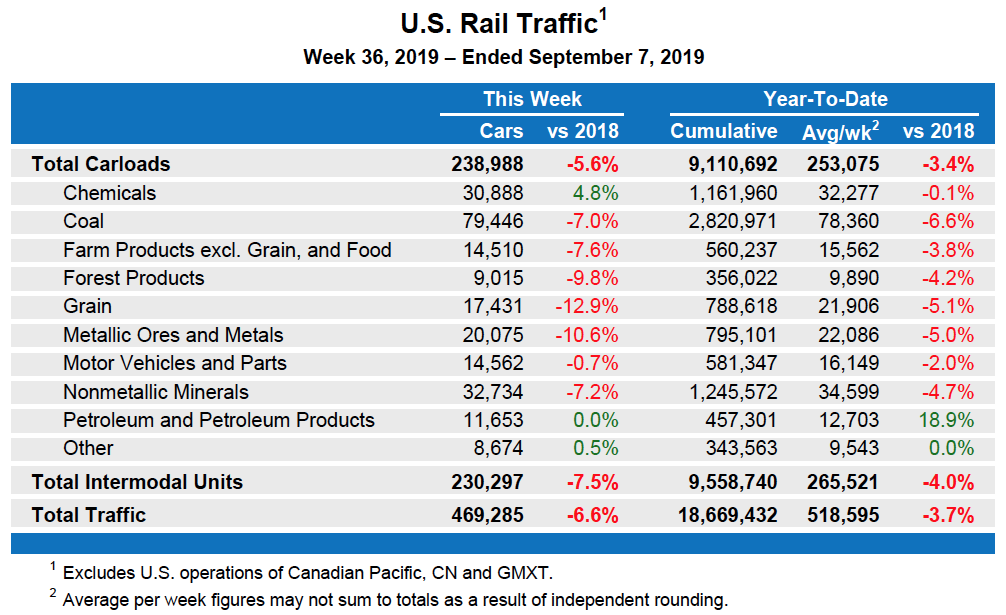For this week, total U.S. weekly rail traffic was 469,285 carloads and intermodal units, down 6.6% compared with the same week last year.
Total carloads for the week ending Sept. 7 were 238,988 carloads, down 5.6% compared with the same week in 2018, while U.S. weekly intermodal volume was 230,297 containers and trailers, down 7.5% compared to 2018.
Three of the 10 carload commodity groups posted an increase compared with the same week in 2018. They were chemicals, up 1,425 carloads, to 30,888; miscellaneous carloads, up 42 carloads, to 8,674; and petroleum and petroleum products, up 1 carload, to 11,653. Commodity groups that posted decreases compared with the same week in 2018 included coal, down 5,965 carloads, to 79,446; grain, down 2,589 carloads, to 17,431; and non-metallic minerals, down 2,524 carloads, to 32,734.
For the first 36 weeks of 2019, U.S. railroads reported cumulative volume of 9,110,692 carloads, down 3.4% from the same point last year; and 9,558,740 intermodal units, down 4% from last year. Total combined U.S. traffic for the first 36 weeks of 2019 was 18,669,432 carloads and intermodal units, a decrease of 3.7% compared to last year.
North American rail volume for the week ending Sept. 7, 2019, on 12 reporting U.S., Canadian, and Mexican railroads totaled 335,381 carloads, down 6% compared with the same week last year, and 312,343 intermodal units, down 6.3% compared with last year. Total combined weekly rail traffic in North America was 647,724 carloads and intermodal units, down 6.2 percent. North American rail volume for the first 36 weeks of 2019 was 25,472,443 carloads and intermodal units, down 2.6% compared with 2018.
Canadian railroads reported 77,774 carloads for the week, down 6%, and 66,136 intermodal units, up 1.4% compared with the same week in 2018. For the first 36 weeks of 2019, Canadian railroads reported cumulative rail traffic volume of 5,455,151 carloads, containers, and trailers, up 1.7%.
Mexican railroads reported 18,619 carloads for the week, down 10.6% compared with the same week last year, and 15,910 intermodal units, down 17.8%. Cumulative volume on Mexican railroads for the first 36 weeks of 2019 was 1,347,860 carloads and intermodal containers and trailers, down 3.6% from the same point last year.
— An Association of American Railroads news release. Sept. 11, 2019















The Bureau of Economic Analysis, which is responsible for declaring when a recession has started, as well as the Federal Reserve, which manages the monetary policy that impacts the economic cycle, are usually six months behind the curve before recognizing that a recession has started.
Just think of the enormity of the data collecting processes and analysis for an economy of more than $21 trillion. It takes months just to figure out where the economy is heading.
In December of 2007, if I remember correctly, the Federal Reserve was arguing that interest rates needed to be maintained relatively high because of a rising fear of inflation. Yet, in fact, the economy had been six or more months into what became the Great Recession.
Weekly figures are practically meaningless. Year to date show a trend that is important. Better yet would be twelve months figures ended September 7, 2019.
What would be the major source(s) for petroleum and petroleum products? Presumably the major destination would be Gulf Coast refineries.
Would petroleum products include petroleum that has been refined into gasoline, diesel, byproducts, etc.?
Does anyone know how many carloads the railroads handled in 1950, 1960, 1970? Or where I can find the information?
I have heard that while the share of goods transported in the United States has fallen significant from the day when the majority of goods were shipped by rail, U.S. railroads actually haul more freight today than ever.
A recession has started. It just hasn’t been announced yet, I suspect for political reasons.
This is not what I was expecting. I had occasion to view the Rochelle Webcam for three or so hours on the 8th and there were a very large number of intermodal trains on both railroads, going both directions.
I had thought I was seeing the start of the Christmas 2019 shipping season. What it must actually mean is that there are very few intermodal trains at other times of the day; resulting in fewer train starts, fewer crew, and fewer engines required. Not a good sign.